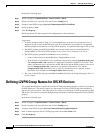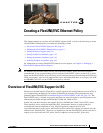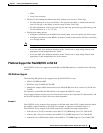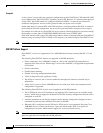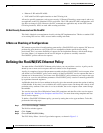
CHAPTER
3-1
Cisco IP Solution Center L2VPN and Carrier Ethernet User Guide, 6.0
OL-21636-01
3
Creating a FlexUNI/EVC Ethernet Policy
This chapter contains an overview of FlexUNI/EVC support in ISC, as well as the basic steps to create
a FlexUNI/EVC Ethernet policy. It contains the following sections:
• Overview of FlexUNI/EVC Support in ISC, page 3-1
• Defining the FlexUNI/EVC Ethernet Policy, page 3-6
• Setting the Service Options, page 3-8
• Setting the FlexUNI Attributes, page 3-10
• Setting the Interface Attributes, page 3-16
• Enabling Template Association, page 3-23
For information on creating FlexUNI/EVC Ethernet service requests, see Chapter 4, “Managing a
FlexUNI/EVC Ethernet Service Request.”
Note For Ethernet (E-Line and E-LAN) services, use of the FlexUNI/EVC policy and service request is
recommended. If you are provisioning services using the FlexUNI/EVC syntax, or plan to do so in the
future, use the FlexUNI/EVC service. Existing services that have been provisioned using the L2VPN and
VPLS service policy types are still supported and can be maintained with those service types. For ATM
and FRoMPLS services, use the L2VPN service policy, as before.
Overview of FlexUNI/EVC Support in ISC
Flexible user network interface (FlexUNI) is a generic approach for creating Ethernet services in ISC. It
can, if supported by the hardware, be used for all Ethernet provisioning. (For information on what
platforms support FlexUNI/EVC see
Platform Support for FlexUNI/EVC in ISC 6.0, page 3-3.) The
FlexUNI/EVC policy is flexible and generic and allows for service designers to provide greater service
offerings than available through traditional ISC L2VPN and VPLS services.
Certain line cards have interfaces that support the Cisco IOS Ethernet Virtual Circuit (EVC) syntax.
These interfaces can be configured with either EVC infrastructure features or with switch-port
command-line interface commands (Class). FlexUNI optionally supports the EVC CLI
syntax/infrastructure. For this reason, the FlexUNI policies and service requests are referred to by the
umbrella term “FlexUNI/EVC.” However, it is important to note that FlexUNI/EVC policies and service
request are not tied to the new EVC syntax. Service endpoints can use non-EVC syntax also.










